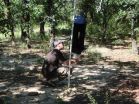The 3D printing technique, known as bioplotting, has taken researchers one step closer to being able to help patients who experience severe hypoglycaemic events, commonly known as 'hypos'- a problem that affects about a third of people with type 1 diabetes according to Diabetes UK.
The paper describes how clusters of specialized cells responsible for the production of insulin and glucagon in the pancreas, called islets of Langerhans, have successfully been 3D printed into a scaffold. It is hoped that the scaffolds can be transplanted into patients with type 1 diabetes to help regulate blood sugar levels and avoid 'hypos'.
In their study, the group of researchers sought to increase the success of islet transplantation by creating bioengineered scaffolds to help deliver the transplanted islet cells into patients, ensuring the cells are protected and fully functioning when placed at the donor site.
The islets were embedded into three-dimensional scaffolds made from an alginate/gelatin mixture with a cross-linked structure and showed full functionality once extracted, meaning that the scaffolds could function as a potential delivery vehicle in future transplantations. The islet cells were included in the liquid hydrogel mixture during printing to create the porous three-dimensional scaffold.
When selecting the material for the scaffold, the researchers had to strike a balance between a liquid mixture that had a high enough viscosity for a strong scaffold to be 3D printed, and a mixture that would not compromise the functionality of the cells when transplanted.
The porous structure of the scaffolds was selected over a bulk material so that it could efficiently facilitate the exchange of glucose and insulin. At the same time, the scaffold was designed to offer protection to the islet cells from the body's immune system, which would recognise the foreign cells and begin to attack them.
It is for this particular reason that current islet transplantation patients need to undergo a lifelong immunosuppressive therapy to avoid rejection of the transplanted donor tissue.
Co-author of the study Dr A A van Apeldoorn, from the University of Twente, said: "Our results showed that once the islet cells were retrieved from the alginate/gelatin scaffolds in the lab they were able to produce insulin and respond to glucose in the same way as non-printed islet cells, indicating that the procedure had not affected their viability or function at all.
"The macroporous scaffolds also ensured that the islet cells would not migrate uncontrollably through the body once transplanted into the donor site.
"If we are to improve the success of this treatment for type 1 diabetes, we need to create an implant in which islets are embedded, or encapsulated, from a material that allows for very efficient oxygen and nutrient supply, and quick exchange of glucose and insulin, while keeping the host cells out.
"Our future research will look further into recreating an optimal islet microenvironment to provide the donor islets with the best transplantation start possible."
INFORMATION:
From Thursday 28 May, this paper can be downloaded from http://iopscience.iop.org/1758-5090/7/2/025009.
Notes to Editors
Contact
1. For further information, a full draft of the journal paper or contact with one of the researchers, contact IOP PR Officer, Alison Hadley: tel: 0117 930 1176, e-mail: alison.hadley@iop.org. For more information on how to use the embargoed material above, please refer to our embargo policy (http://journalists.iop.org/journalistLogin/embargoPolicy).
IOP Publishing Journalist Area
2. The IOP Publishing Journalist Area (http://journalists.iop.org/journalistLogin) gives journalists access to embargoed press releases, advanced copies of papers, supplementary images and videos. Login details also give free access to IOPscience, IOP Publishing's journal platform. To apply for a free subscription to this service, please email the IOP Publishing Press team at ioppublishing.press@iop.org, with your name, organisation, address and a preferred username.
Fabrication of three-dimensional bioplotted hydrogel scaffolds for iselts of Langerhans transplantations
3. The published version of the paper 'Fabrication of three-dimensional bioplotted hydrogel scaffolds for islets Langerhans transplantations' (Marchioli et al 2015 Biofabrication 7 025009) will be freely available online from Thursday 28 May. It will be available at iopscience.iop.org/1758-5090/7/2/025009.
Biofabrication
4. Biofabrication focuses on cutting-edge research regarding the use of cells, proteins, biological materials and biomaterials as building blocks to manufacture biological systems and/or therapeutic products. It focuses on the development of fabrication technologies, the modelling of the fabricated constructs and the maturation of biofabricated objects towards the intended tissue types.
IOP Publishing
5. IOP Publishing provides publications through which leading-edge scientific research is distributed worldwide.
Beyond our traditional journals programme, we make high-value scientific information easily accessible through an ever-evolving portfolio of books, community websites, magazines, conference proceedings and a multitude of electronic services.
IOP Publishing is central to the Institute of Physics, a not-for-profit society. Any financial surplus earned by IOP Publishing goes to support science through the activities of the Institute.
Go to http://ioppublishing.org or follow us @IOPPublishing.
Access to Research
6. Access to Research is an initiative through which the UK public can gain free, walk-in access to a wide range of academic articles and research at their local library. This article is freely available through this initiative. For more information, go to http://www.accesstoresearch.org.uk.
The Institute of Physics
7. The Institute of Physics is a leading scientific society. We are a charitable organisation with a worldwide membership of more than 50,000, working together to advance physics education, research and application.
We engage with policymakers and the general public to develop awareness and understanding of the value of physics and, through IOP Publishing, we are world leaders in professional scientific communications.
In September 2013, we launched our first fundraising campaign. Our campaign, Opportunity Physics, offers you the chance to support the work that we do.
Visit us at http://www.iop.org or follow us on Twitter @physicsnews.
